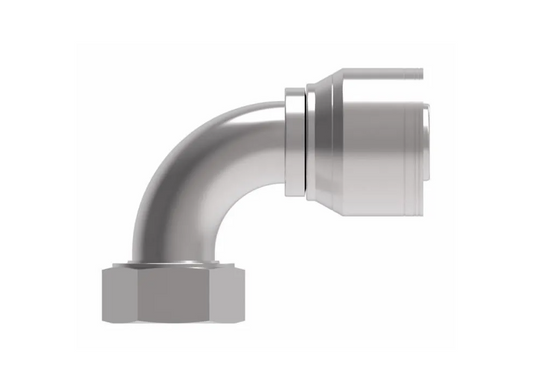-
O-Ring Face Seal (ORFS) Female 90˚ Tube Elbow
Regular price From $13.99 USDRegular priceUnit price / per$10.33 USDSale price From $13.99 USD -
O-Ring Face Seal (ORFS) Female Swivel
Regular price From $9.99 USDRegular priceUnit price / per$15.40 USDSale price From $9.99 USDSale -
O-Ring Face Seal (ORFS) Female Swivel 45˚ Tube Elbow
Regular price From $12.24 USDRegular priceUnit price / per -
O'RING FACE SEAL (ORFS) MALE RIGID
Regular price From $7.99 USDRegular priceUnit price / per
O-ring Face Seal Fittings - Hydraulic Fittings FAQs
Collapsible content
1. What are o-ring face seal fittings and how do they work to prevent leaks between components?
O-ring face seal fittings use the compression of an o-ring gasket between two flat face fittings to create a very strong seal that prevents leaks even under high pressures and vibration. The o-ring fits into a machined groove and gets compressed between the male and female fittings during assembly.
2. What is the difference between standard o-rings and o-ring face seals? What are the benefits of the face seal design?
An o-ring face seal differs from a standard o-ring by having a flat face machine finish on each fitting component side that compresses the rubber o-ring gasket upon connection and assembly rather than just having an o-ring fit in a groove. This allows better sealing, especially for high pressure applications.
3. When should I choose an o-ring face seal fitting over other types of threaded fittings? In what applications are they best suited?
O-ring face seal fittings are ideal for use in hydraulic systems, chemical processing lines, gas lines, and anywhere leaks must be prevented reliably. The compressed flat face o-ring seal can handle higher pressures than threaded connections alone without leaks between components.
4. What is the meaning of "straight thread" and "flat face" in describing o-ring face seal fittings?
A “straight thread” refers to fittings with parallel threads while a “flat face” is the machined smooth surface that compresses the o-ring gasket. This keeps the seal in place.
5. Why are machined grooves important in the proper functioning of ring face seal fittings?
The machined groove in both the male and female face seal fitting allows proper positioning, support, and compression of the rubber o-ring gasket during tightening and assembly. This ensures the gasket seats properly to prevent leaks.
6. How do o-ring face seal fittings handle vibration compared to fittings without a compressed face seal?
The compressed o-ring in an o-ring face seal fitting can maintain its tight seal even with vibration which could loosen standard threaded connections. The elastomeric seal compensates for vibrations.
7. What level of torque should be applied to properly compress the seal when assembling male and female o-ring face seal fittings?
Proper torque should be applied during installation of o-ring face seal fittings to ensure sufficient compressive force on the o-ring without damage by overtightening. Torque values depend on line size and pressure rating.
8. How do the leak prevention capabilities of o-ring face seal fittings under high pressures compare to traditional threaded connections with no seal?
In testing, o-ring face seals on fittings properly assembled can seal water pressures over 1,000 PSI without leaking while standard threaded connections may leak at 100 PSI.
9. What is the proper procedure for disassembling a connection made with o-ring face seal fittings?
To disassemble, first relieve any system pressure. Then use the proper size wrench across flats to loosen the male and female o-ring face seal fitting, taking care not to scratch the machined flat sealing face surfaces.




